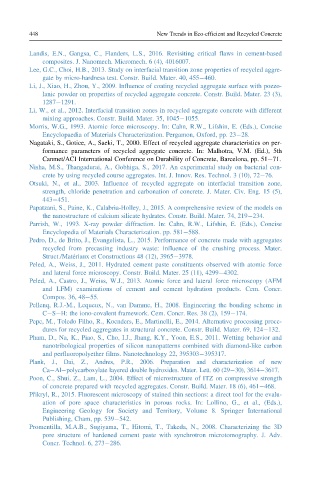Page 498 - New Trends in Eco efficient and Recycled Concrete
P. 498
448 New Trends in Eco-efficient and Recycled Concrete
Landis, E.N., Gangsa, C., Flanders, L.S., 2016. Revisiting critical flaws in cement-based
composites. J. Nanomech. Micromech. 6 (4), 4016007.
Lee, G.C., Choi, H.B., 2013. Study on interfacial transition zone properties of recycled aggre-
gate by micro-hardness test. Constr. Build. Mater. 40, 455 460.
Li, J., Xiao, H., Zhou, Y., 2009. Influence of coating recycled aggregate surface with pozzo-
lanic powder on properties of recycled aggregate concrete. Constr. Build. Mater. 23 (3),
1287 1291.
Li, W., et al., 2012. Interfacial transition zones in recycled aggregate concrete with different
mixing approaches. Constr. Build. Mater. 35, 1045 1055.
Morris, W.G., 1993. Atomic force microscopy. In: Cahn, R.W., Lifshin, E. (Eds.), Concise
Encyclopaedia of Materials Characterization. Pergamon, Oxford, pp. 23 28.
Nagataki, S., Gotice, A., Saeki, T., 2000. Effect of recycled aggregate characteristics on per-
formance parameters of recycled aggregate concrete. In: Malhotra, V.M. (Ed.), 5th
Canmet/ACI International Conference on Durability of Concrete, Barcelona, pp. 51 71.
Nisha, M.S., Thangadurai, A., Gobhiga, S., 2017. An experimental study on bacterial con-
crete by using recycled course aggregates. Int. J. Innov. Res. Technol. 3 (10), 72 76.
Otsuki, N., et al., 2003. Influence of recycled aggregate on interfacial transition zone,
strength, chloride penetration and carbonation of concrete. J. Mater. Civ. Eng. 15 (5),
443 451.
Papatzani, S., Paine, K., Calabria-Holley, J., 2015. A comprehensive review of the models on
the nanostructure of calcium silicate hydrates. Constr. Build. Mater. 74, 219 234.
Parrish, W., 1993. X-ray powder diffraction. In: Cahn, R.W., Lifshin, E. (Eds.), Concise
Encyclopedia of Materials Characterization. pp. 581 588.
Pedro, D., de Brito, J., Evangelista, L., 2015. Performance of concrete made with aggregates
recycled from precasting industry waste: influence of the crushing process. Mater.
Struct./Mate ´riaux et Constructions 48 (12), 3965 3978.
Peled, A., Weiss, J., 2011. Hydrated cement paste constituents observed with atomic force
and lateral force microscopy. Constr. Build. Mater. 25 (11), 4299 4302.
Peled, A., Castro, J., Weiss, W.J., 2013. Atomic force and lateral force microscopy (AFM
and LFM) examinations of cement and cement hydration products. Cem. Concr.
Compos. 36, 48 55.
Pellenq, R.J.-M., Lequeux, N., van Damme, H., 2008. Engineering the bonding scheme in
C S H: the iono-covalent framework. Cem. Concr. Res. 38 (2), 159 174.
Pepe, M., Toledo Filho, R., Koenders, E., Martinelli, E., 2014. Alternative processing proce-
dures for recycled aggregates in structural concrete. Constr. Build. Mater. 69, 124 132.
Pham, D., Na, K., Piao, S., Cho, I.J., Jhang, K.Y., Yoon, E.S., 2011. Wetting behavior and
nanotribological properties of silicon nanopatterns combined with diamond-like carbon
and perfluoropolyether films. Nanotechnology 22, 395303 395317.
Plank, J., Dai, Z., Andres, P.R., 2006. Preparation and characterization of new
Ca Al polycarboxylate layered double hydroxides. Mater. Lett. 60 (29 30), 3614 3617.
Poon, C., Shui, Z., Lam, L., 2004. Effect of microstructure of ITZ on compressive strength
of concrete prepared with recycled aggregates. Constr. Build. Mater. 18 (6), 461 468.
Pˇ rikryl, R., 2015. Fluorescent microscopy of stained thin sections: a direct tool for the evalu-
ation of pore space characteristics in porous rocks. In: Lollino, G., et al., (Eds.),
Engineering Geology for Society and Territory, Volume 8. Springer International
Publishing, Cham, pp. 539 542.
Promentilla, M.A.B., Sugiyama, T., Hitomi, T., Takeda, N., 2008. Characterizing the 3D
pore structure of hardened cement paste with synchrotron microtomography. J. Adv.
Concr. Technol. 6, 273 286.

